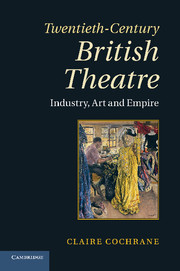Book contents
- Frontmatter
- Contents
- Acknowledgements
- Introduction
- Chapter 1 The topography of theatre in 1900
- Chapter 2 Structures of management
- Chapter 3 The profession of acting
- Chapter 4 The amateur phenomenon
- Chapter 5 The topography of theatre in 1950
- Chapter 6 The business of theatre
- Chapter 7 The changing demographic of performance
- Chapter 8 The topography of theatre in 2000
- Conclusion
- Notes
- Select Bibliography
- Index
Conclusion
Published online by Cambridge University Press: 05 November 2011
- Frontmatter
- Contents
- Acknowledgements
- Introduction
- Chapter 1 The topography of theatre in 1900
- Chapter 2 Structures of management
- Chapter 3 The profession of acting
- Chapter 4 The amateur phenomenon
- Chapter 5 The topography of theatre in 1950
- Chapter 6 The business of theatre
- Chapter 7 The changing demographic of performance
- Chapter 8 The topography of theatre in 2000
- Conclusion
- Notes
- Select Bibliography
- Index
Summary
Looking back over the one-hundred-year segment of the twentieth century, what conclusions can be reached about continuity and change in British theatre? I suspect that in 1900 relatively few could have confidently predicted the colossal changes in mass creative communication soon to be wrought by the electronic media. It is thus in the arena of technological innovation that the new continuity was forged. Throughout the book I have examined the impact this had on the making of live theatre: on the diversifying of opportunity for actors and the evidence that regional and national differences could be more readily recognised and disseminated. At the same time the economics of cinema and, then, as a more durable presence, television, not only meant that live theatre was no longer the dominant form of popular entertainment, but the major disparities in revenue-generation capacity linked to the concentration of centres of production in or near London also contributed to the contraction of the human and financial resources available for more ambitious theatre projects across the UK. By 2000 the digital revolution was well under way in transforming the means by which performance could be virtually manipulated and transmitted. Artists who remained committed to the live interaction of actor and audience in the same physically shared spaces were squaring up to the threat of another major technological change. And yet theatre-makers were proving adept, as always, in absorbing and working with change.
At my own university in Worcester, the resident C&T Theatre Company, which as the small theatre-in-education company Collar and Tie had faced liquidation within a bleak educational and local authority environment, had transformed itself by using new technology to enhance the participatory experience of young people in schools. Funded by Arts Council England and the West Midlands Regional Arts Board, which had designated it a Key Regional Organisation, C&T also received European funding through the European Social Fund Objective 5B targeted at work in isolated rural areas. In 2000 further boosted by a capital Lottery grant of £83,000, the company was travelling around Herefordshire and Worcestershire with two Touring Digital Media Units. Both a successful SME and a small-scale example of the exemplary theatre operating at the grass-roots of the community, C&T was clearly in the vanguard of change, but with artistic and pedagogic principles which would have been very familiar to the rural touring initiatives of the 1920s.
- Type
- Chapter
- Information
- Twentieth-Century British TheatreIndustry, Art and Empire, pp. 271 - 275Publisher: Cambridge University PressPrint publication year: 2011



